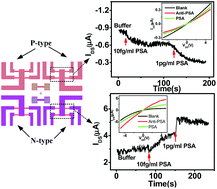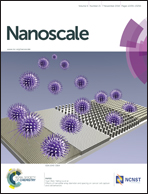Direct ultrasensitive electrical detection of prostate cancer biomarkers with CMOS-compatible n- and p-type silicon nanowire sensor arrays†
Abstract
Sensitive and quantitative analysis of proteins is central to disease diagnosis, drug screening, and proteomic studies. Here, a label-free, real-time, simultaneous and ultrasensitive prostate-specific antigen (PSA) sensor was developed using CMOS-compatible silicon nanowire field effect transistors (SiNW FET). Highly responsive n- and p-type SiNW arrays were fabricated and integrated on a single chip with a complementary metal oxide semiconductor (CMOS) compatible anisotropic self-stop etching technique which eliminated the need for a hybrid method. The incorporated n- and p-type nanowires revealed complementary electrical response upon PSA binding, providing a unique means of internal control for sensing signal verification. The highly selective, simultaneous and multiplexed detection of PSA marker at attomolar concentrations, a level useful for clinical diagnosis of prostate cancer, was demonstrated. The detection ability was corroborated to be effective by comparing the detection results at different pH values. Furthermore, the real-time measurement was also carried out in a clinically relevant sample of blood serum, indicating the practicable development of rapid, robust, high-performance, and low-cost diagnostic systems.


 Please wait while we load your content...
Please wait while we load your content...